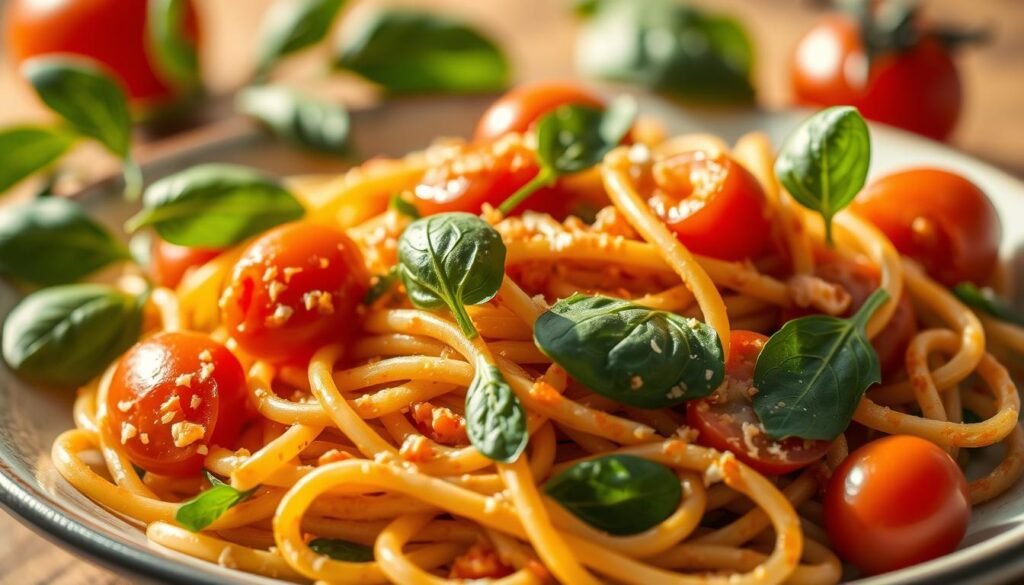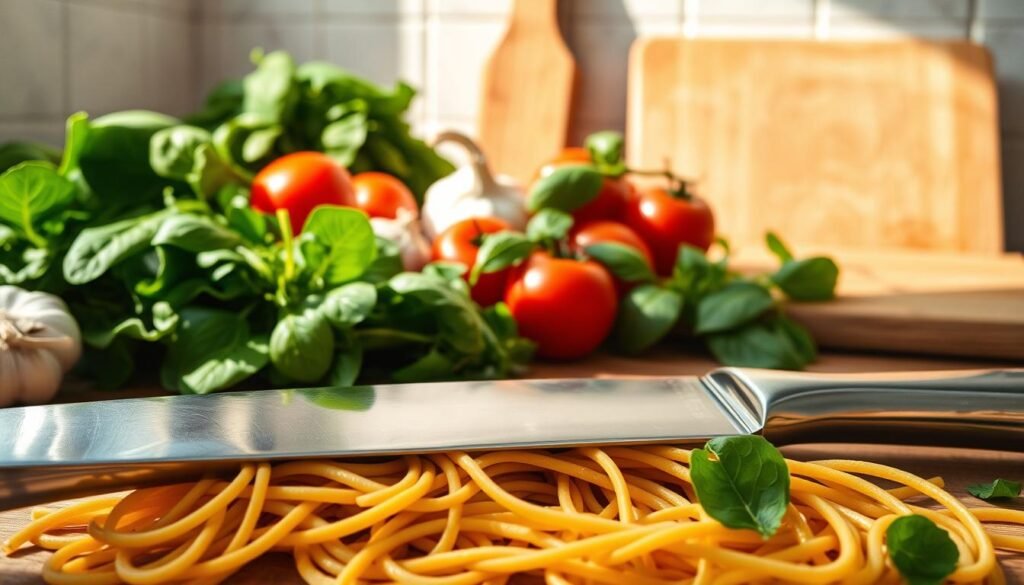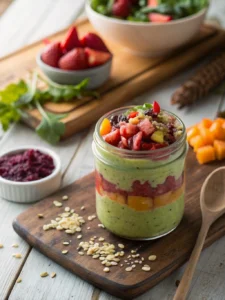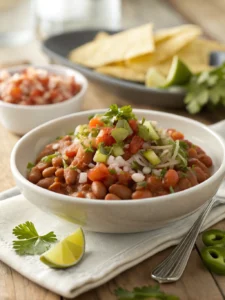Every year, Americans eat over 4.4 billion pounds of pasta. It’s a favorite in many kitchens. Spinach tomato pasta adds a nutritional boost to this classic dish. It’s made with tender spinach, juicy tomatoes, and al dente pasta, ready in under 30 minutes.
It’s perfect for both beginners and experienced cooks. This recipe is a blank canvas for creativity. It also packs vitamins, fiber, and bold flavors.
Imagine a dish that turns leafy greens and ripe tomatoes into a silky, savory sauce. No heavy cream needed. This guide shows how to mix fresh ingredients, pick the right pasta shape, and master techniques like blanching spinach or making a rich tomato base.
Our Pasta is great for quick dinners or dinner parties. It’s adaptable and keeps your plate colorful and healthy.
Key Takeaways
- Spinach tomato pasta combines convenience with nutrients like iron and vitamin C.
- Simple techniques transform basic ingredients into a restaurant-quality dish.
- Adjust the recipe with protein, cheese, or whole-grain pasta to fit dietary needs.
- Wine pairings enhance the dish’s bright flavors without overwhelming them.
- Mastering ratios and cooking times ensures every bite bursts with balanced taste.
Introduction to Spinach Tomato Pasta
Spinach tomato pasta is a vibrant dish that highlights fresh spinach and ripe tomatoes. It’s a quick and tasty meal that’s easy to make. It’s perfect for busy nights because it combines greens with pasta in a way everyone loves.

Why This Dish Is a Weeknight Favorite
- Cooking time under 30 minutes means you can eat in less time than it takes to order takeout.
- Uses pantry staples like pasta, canned tomatoes, and fresh spinach—no exotic ingredients required.
- Customizable with pantry proteins or herbs to match your taste or leftovers.
The Perfect Balance of Nutrition and Flavor
Spinach inside pasta adds fiber and vitamins without overpowering the dish. Tomatoes add a tangy sweetness that brightens it. The pasta makes it comforting. Pro tip: Add a sprinkle of Parmesan for extra creaminess.
What Makes This Recipe Special
Unlike plain pasta, spinach tomato pasta hides nutrients in every bite. The spinach blends into sauces effortlessly, making it a stealthy way to boost greens intake. Its flexibility lets you experiment: try swapping penne for fusilli or adding garlic for depth. Every bite feels like a small victory for both taste and wellness.
Essential Ingredients for the Perfect Spinach Tomato Pasta
Mastering spinach tomato pasta begins with picking the right ingredients. Freshness and quality are key. Here’s what you need:

- Spinach: Choose baby spinach for its tenderness. Pre-washed saves time.
- Tomatoes: Cherry tomatoes add sweetness, while Roma tomatoes offer a firm texture.
- Pasta: Short shapes like penne or fusilli are best for holding sauce.
- Creamy additions: Heavy cream or coconut milk make creamy spinach pasta richer.
- Aromatics: Garlic and shallots are the flavor foundation.
| Classic Spinach Tomato Pasta | Creamy Spinach Pasta |
|---|---|
| Tomato puree, olive oil | Cream cheese, grated Parmesan |
| Basil leaves | Nutritional yeast (dairy-free option) |
Season with red pepper flakes for warmth and lemon zest for brightness. Always use extra-virgin olive oil for its strong flavor. Fresh basil adds brightness, while dried herbs are a good backup.
Selecting the Best Pasta for Your Spinach and Tomato Dish
Choosing the right pasta shape is key for a great spinach and tomato dish. Short pasta like penne, fusilli, or farfalle keeps spinach pieces mixed well. Their ridges also hold sauce and ingredients, making the dish cohesive.
For example, fusilli’s spiral twists wrap around chopped spinach, adding texture. This makes the spinach inside pasta a delightful experience.
Short Pasta Options
- Penne: Its tubular shape traps small spinach bits in its hollow ends.
- Fusilli
: Twisted spirals hold chunky tomato sauce and spinach.
- Farfalle (bowtie)
: Flattened edges catch wilted spinach when tossed with sauce.
Long Pasta Choices
Spaghetti or linguine are best when spinach is finely chopped or sautéed. Their smooth surfaces pair well with silky tomato-based sauces. When cooking long strands, gently wilt leaves first to avoid sogginess.
Whole Wheat and Gluten-Free Options
- Whole wheat pasta adds fiber; its nutty taste complements earthy spinach.
- Gluten-free options like brown rice or chickpea pasta require shorter cook times to prevent mushiness.
- Pair with olive oil-based sauces to enhance texture and retain spinach’s vibrant green color.
Experiment with shapes to match your preferred spinach texture. Short pasta keeps spinach inside pasta visible, while long strands blend ingredients smoothly. Adjust cooking methods based on pasta type to ensure optimal flavor and texture.
How Do You Cook Spinach for Pasta: Techniques and Tips
Learning the best way to cook spinach is key for a tasty pasta dish. Here’s how to pick the right method for your recipe.
Blanching vs. Sautéing Spinach
Blanch spinach by boiling it for 20-30 seconds, then cool it in ice water. This makes the leaves crisp-tender, perfect for pasta. For a smooth mix, sauté spinach with olive oil and garlic until it’s soft. This is great for creamy sauces.
Preserving Spinach Color and Nutrients
- Use a pinch of baking soda in water when blanching to keep the green color.
- Cook spinach briefly—overcooking makes it lose color and nutrients.
- Add spinach last when mixing with pasta to keep it fresh.
Determining the Perfect Spinach-to-Pasta Ratio
Start with 2 cups fresh spinach for every 8 oz pasta. Since spinach wilts a lot, 2 cups become about ½ cup cooked. If you want spinach to be the main ingredient, double the raw amount.
Try these methods to find the right balance of texture and nutrition. Whether you blanch or sauté, spinach brings a rich flavor without taking over the pasta’s taste.
Creating a Flavorful Tomato Base
Start by heating olive oil in a skillet. Add minced garlic and diced onions, cooking until golden. This aromatic base forms the foundation of your spinach tomato pasta. Next, incorporate a tablespoon of tomato paste, stirring until it darkens—this step boosts umami depth.
Choose between fresh or canned tomatoes. Fresh varieties work best in peak season, while San Marzano canned tomatoes offer consistency year-round. Crush them by hand for a rustic texture or pulse in a blender for a silky sauce. Simmer everything together for 15-20 minutes, letting flavors meld.
- Use 1/4 cup tomato paste for a savory backbone
- Balance acidity with a pinch of sugar if needed
- Reserve pasta water to adjust sauce consistency
To transform this into creamy cream cheese tomato pasta, remove the pan from heat. Stir in 4-6 ounces of softened cream cheese until melted. A splash of reserved pasta water helps emulsify the mixture, preventing separation. This step elevates the dish to a rich, indulgent version.
“A great sauce is built in layers, never rushed.” – Culinary adage
Season aggressively with salt and black pepper. Taste and adjust acidity by adding lemon juice or more sugar if needed. This base adapts easily—use it as a vibrant companion for spinach in the main dish or as a standalone pasta sauce. The key is patience; slow simmering develops complexity essential to both classic and creamy versions.
Step-by-Step Guide to Preparing Creamy Spinach Pasta
Learning to make creamy spinach pasta requires attention to detail. Start by rinsing the spinach and drying it. Then, chop garlic and slice cherry tomatoes for a burst of flavor. For creamy cream cheese tomato pasta, soften butter and let cream cheese warm up to mix well.
Prepping Your Ingredients
- Wash spinach and tear into bite-sized pieces.
- Chop shallots or garlic and set tomatoes aside for later steps.
- If using cream cheese, let it sit at room temperature for 10 minutes.
Cooking the Perfect Al Dente Pasta
Start by boiling a lot of water and add salt. Cook the pasta 1-2 minutes less than the package says. Before draining, save 1 cup of pasta water—it helps thicken sauces. Check the pasta for a slight firmness before moving it to a bowl.
Combining Components for Maximum Flavor
- Sauté garlic and onions until they’re soft.
- Add tomatoes and cook until they start to release their juices.
- Whisk in cream cheese and milk over medium heat until it’s smooth.
- Stir in spinach until it’s fully wilted, then mix with the pasta.
- Adjust the sauce’s thickness with the pasta water. Serve right away.
Let the dish sit for 1-2 minutes after mixing to let the flavors blend. Top with Parmesan or red pepper flakes for more flavor.
Variations on Classic Spinach Tomato Pasta
Start with the basic spinach tomato pasta and then try new things. Each change adds flavor or health benefits.
Creamy Cream Cheese Tomato Pasta Option
- Stir in 4–6 ounces of cream cheese when the tomato mix simmers.
- Add ¼ cup heavy cream or half-and-half for more richness.
- Melt the cream cheese slowly to avoid lumps. This makes a smooth creamy cream cheese tomato pasta base.
Protein Add-Ins for Complete Meals
- Cook diced chicken breast in olive oil until golden, then toss into the pasta.
- Saute shrimp for 2–3 minutes in the sauce to keep them tender.
- For vegan options, pan-fry cubed extra-firm tofu until crisp, then mix in.
Vegetable Boosters Beyond Basics
- Roasted red peppers or sun-dried tomatoes add smoky sweetness.
- Cherry tomatoes burst with juice when halved and cooked briefly.
- Try zucchini ribbons or roasted mushrooms for earthy depth.
Top any of these with Parmesan or crushed red pepper. The spinach tomato pasta base is versatile. It makes leftovers exciting every time.
Time-Saving Tips for Quick Weeknight Preparation
Make spinach tomato pasta in just 20 minutes with these tips. Start by prepping ingredients ahead. Wash and dry spinach, chop garlic and onions, and store them in airtight containers in your fridge for up to two days.
- Prep smart: Chop veggies and marinate herbs the night before. Use frozen spinach (thawed and drained) for quick meals.
- Speedy sauce base: Choose jarred tomato sauce like Prego or Ragu. Add fresh basil, red pepper flakes, or balsamic vinegar for extra flavor.
- Quick spinach technique: Add raw spinach to hot sauce without blanching. It wilts instantly, saving time.
- Boil first, multitask next: Start pasta water boiling. Use this time to prep veggies and seasonings.
- Pantry power: Keep frozen spinach, heavy cream, and pre-grated Parmesan on hand. They save a lot of time.
- One-pot magic: Cook pasta until al dente, then drain. Toss it back into the pot with sauce. Simmer until flavors mix well. No extra pots to clean.
For how do you cook spinach for pasta fast? Add it raw to the sauce pan—it’s ready in seconds. Pair it with quick-cook pasta like Barilla Quick! or DeLallo’s 5-minute varieties for a meal under 20 minutes.
Wine Pairing Suggestions for Your Spinach Tomato Pasta
Make your spinach tomato pasta even better with the right drinks. Here’s how to find the perfect match:
Red Wine Options
Medium-bodied red wines are great with tomato flavors:
- Chianti Classico: It has bright cherry notes and balanced acidity. This pairs well with tomato sauces, cutting through their richness.
- Barbera d’Alba: It has dark berry flavors and acidity. This is perfect for dishes with lots of tomatoes.
White Wine Selections
For creamy spinach pasta or dishes with herbs, try these:
- Unoaked Chardonnay: Its butteriness matches the creamy pasta. Choose unoaked for a clean finish.
- Sauvignon Blanc: It has grassy notes that mirror fresh spinach. It’s great with dishes that have herbs.
- Off-dry Riesling: A hint of sweetness contrasts with tomato acidity, adding brightness.
Non-Alcoholic Pairings
Here are some refreshing non-alcoholic options:
- Sparkling water with lemon and basil: It’s crisp and herb-forward, lightening rich dishes.
- San Pellegrino Limonata: Tart citrus balances creamy or tomato-based sauces.
- Pomegranate mocktail: Mix pomegranate juice and soda for a non-alcoholic “wine” alternative.
Nutritional Benefits of Spinach Inside Pasta Dishes
Adding spinach to pasta, like creamy spinach pasta, makes a meal super nutritious. Each bite is packed with vitamins, minerals, and antioxidants. Plus, it doesn’t add many calories. Here’s what you get:
| Nutrient | Key Benefits |
|---|---|
| Vitamin K | Supports bone health and blood clotting |
| Vitamin A | Boosts immunity and eye health |
| Vitamin C | Strengthens immunity and aids iron absorption |
| Folate | Essential for cell growth and pregnancy health |
Spinach’s iron works well with tomato’s vitamin C in pasta, helping iron get absorbed better. Even a cup of raw spinach (which cooks down to a quarter-cup) adds fiber and magnesium for muscle health. The cream in creamy spinach pasta isn’t just for taste—it helps your body soak up vitamins A and E from the greens.
Try this: Mix wilted spinach into pasta while it’s cooking for a nutritional boost. Its mild taste blends well, making every bite healthier. Whether you pick creamy spinach pasta or tomato-based dishes, spinach makes both taste and health better.
Conclusion: Mastering the Art of Spinach Tomato Pasta
With the techniques from this guide, you’re set to make spinach tomato pasta that’s both fresh and comforting. Choose the right pasta, like penne or spaghetti, to start. Learn how to cook spinach: blanching keeps it green, while sautéing adds flavor. This way, every bite is a burst of taste.
This dish is more than just food—it’s a canvas for creativity. Try adding shrimp or tofu, or add roasted peppers for extra flavor. Serve it with a glass of Pinot Grigio or sparkling water for a fun twist. You can make it your own, perfect for quick meals or parties.
Spinach tomato pasta is not only healthy but also versatile. Try adding cream cheese or using whole-grain pasta to make it your own. With time, you’ll get the flavors and textures just right. Now, turn your kitchen into a place to experiment and create.
FAQ
What is the best way to prepare spinach for pasta dishes?
You can prepare spinach for pasta by blanching or sautéing. Blanching means quickly boiling the spinach for 20-30 seconds, then cooling it in ice water. This keeps its color bright. Sautéing cooks the spinach in olive oil with garlic for 1-2 minutes until it wilts. Both methods keep the spinach’s nutrients.
Can I use frozen spinach for my spinach tomato pasta?
Yes, frozen spinach is easy to use. Just thaw and drain it well before adding it to your pasta. This prevents the sauce from getting too watery. Frozen spinach works well in creamy pasta dishes.
Is there a way to make my spinach tomato pasta creamier?
For creamier pasta, add heavy cream or cream cheese to your sauce. A creamy sauce can be made by mixing softened cream cheese into your tomato base. This makes the sauce smooth and rich.
What types of tomatoes work best for spinach tomato pasta?
Cherry or Roma tomatoes are best for flavor. If fresh tomatoes are not available, use high-quality canned tomatoes. San Marzano tomatoes are a great choice for their rich flavor.
How can I store leftovers of spinach tomato pasta?
Keep leftovers in an airtight container in the fridge for 3-4 days. When reheating, add a bit of water or olive oil to keep it creamy.
What’s a good spinach-to-pasta ratio for balance in flavor?
Start with 2 cups of fresh spinach for 8 ounces of pasta. This balance is perfect without too much spinach. Adjust to your taste!
Are there any healthy additions I can include in my spinach tomato pasta?
Yes! Add protein like grilled chicken, shrimp, or tofu. You can also add vegetables like mushrooms, bell peppers, or zucchini. This boosts nutrition and flavor.
What kind of pasta works best with spinach tomato dishes?
Short pasta like penne, fusilli, or farfalle is best. They hold the sauce well and mix with spinach. Long pasta like spaghetti or linguine works too, especially with finely chopped spinach.
Can I use different types of cheese in my creamy spinach pasta?
Yes! Try Parmesan for extra flavor or a dairy-free cheese for vegan options. Adjust the seasoning to balance the taste.



